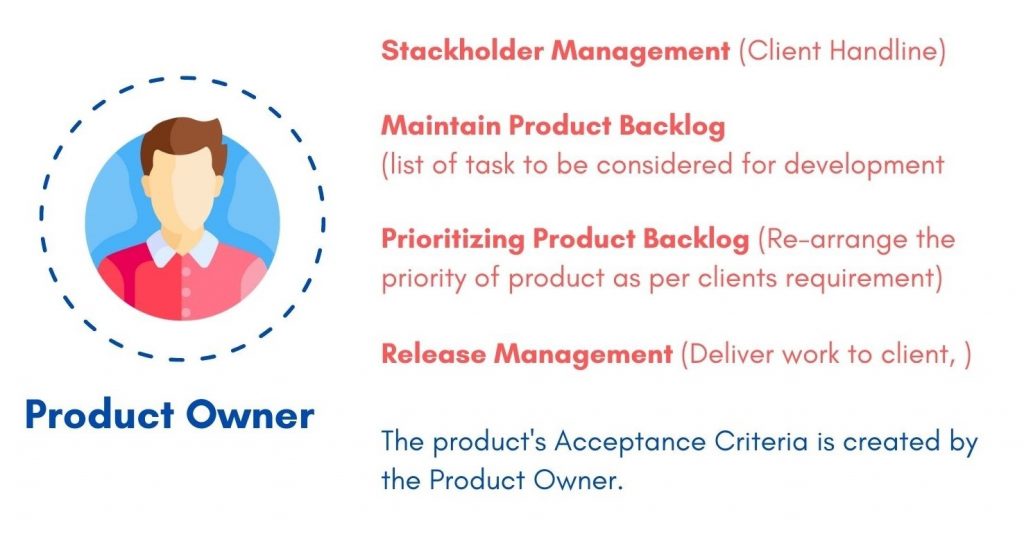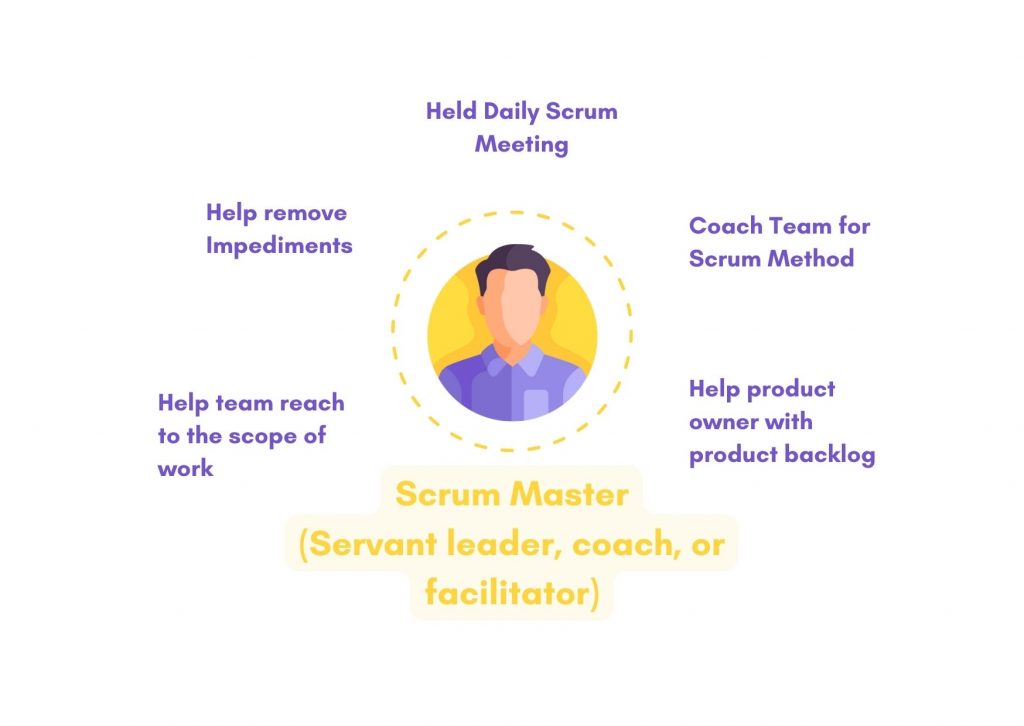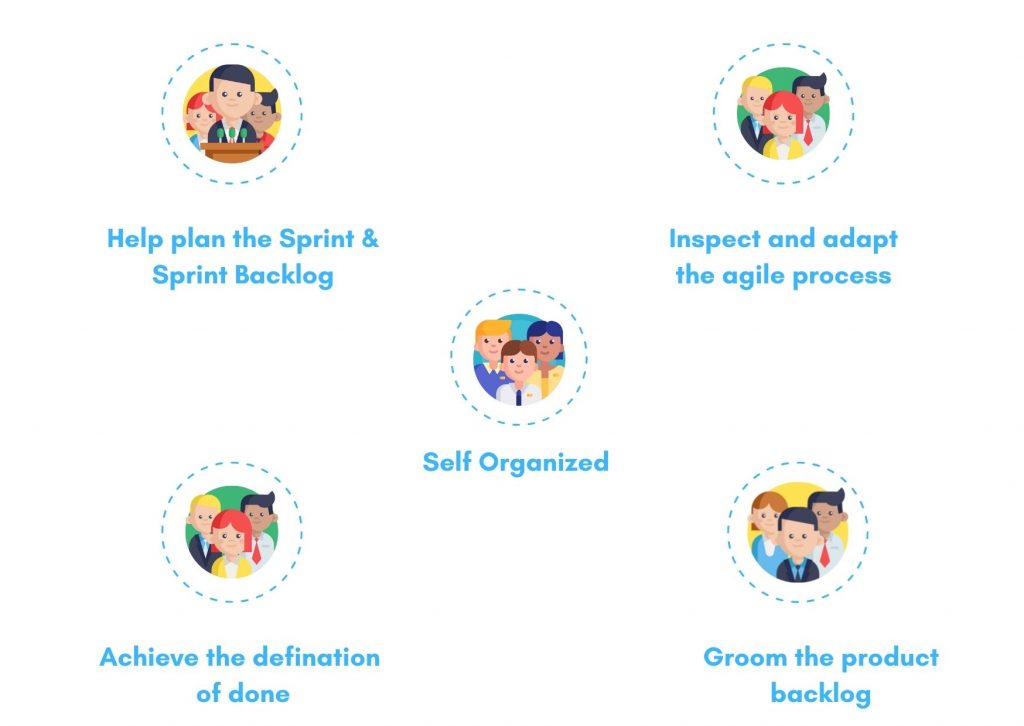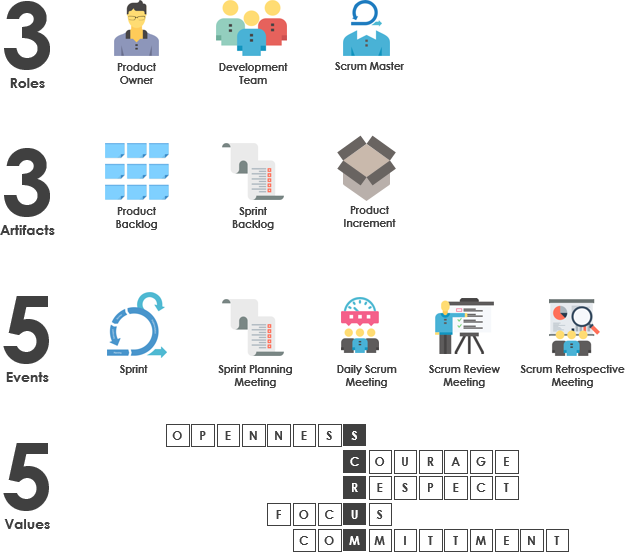Insights on Agile Scrum Methodology
Scrum is a lightweight framework that organizations use to have a systematic workflow of the project. It is a flexible process in which the product is maintained into the sprint and product backlog form.
Scrum consists of 3-5-3 of Scrum – 3 Roles, 5 Events, 3 Artifacts
Scrum Roles:
Product Owner:
A product owner is a part of the scrum team and a primary point of contact with customers. The responsibilities of a product owner are to gather requirements from clients and organize them as per the client’s requirements and feasibility.
In scrum meeting: The product owner plays no role in scrum meetings but can be the audience.
The Scope of work and Acceptance Criteria is defined by the Product Owner.

Scrum Master:
Scrum master is a bridge between the product owner and the scrum team. It helps the product owner with the product backlog and adds the task to the sprint backlog. The scrum master is in charge of keeping the scrum team aligned with the agile method, providing coaching and mentoring, and helping the team with any impediments faced during the sprint. It is the scrum master’s responsibility to make sure the work gets delivered on time satisfying the definition of done.

Scrum master’s responsibility towards team:
- Coaching team regarding the scrum method.
- Helps the development team to create a product that meets the definition of done.
- Facilitating daily scrum meetings:
What did you do yesterday?
What will you do today?
Are there any obstacles in your way? - Helps remove impediments
Scrum master’s responsibility towards product owner:
- Helps product owner with product backlog
- Facilitating scrum events as needed.
Development Team:
It is a team of technically sound people which includes Designers, Developers, and Testers. It’s a self-organized team who adapts and follows agile form. The development team should be between three and nine people.

Development team responsibility:
- Check software quality
- Technical implementation of user stories
- Delivery of functional software increment
- Organize themselves accordingly
- Help team to meet definition of done
- Self-organized
- Plan the sprint
- Inspect and adapt the process
- Team player
They are the people who help Sprint Planning and Sprint Backlog and Achieve definition of done.
Scrum Events:
Sprint Planning:
Sprint planning is the kickoff of a sprint from the product backlog where the entire team collaborates and discusses which task to be considered next spring as per priority provided by the product owner.
The development team then forecasts how many tasks they can deliver the work. The outcome of sprint planning is to set sprint goals and add other tasks to the sprint backlog.
Who can attend?
Scrum team: Product Owner, Scrum Master & Development Team.
Time limit to spend on sprint planning?
Maximum 8 hrs. to spend on planning. But also, the team should schedule a sprint planning meeting for 2 hrs. for a 2-week sprint and 8 hrs. for one month sprint.
Daily Scrum Meeting:
To be updated regarding the progress of the work in scrum, daily scrum meetings are scheduled every day for 15 min. It’s a daily standup meeting to get updates regarding work from previous scrum meetings and updates for the next 24 hrs.
It is important to keep in consideration that the scrum meeting is timeboxed for 15 min every day.
Who can attend:
Scrum Master, Development Team, (Product owner and Stakeholder can attend but as an audience).
Sprint Review:
This is the timeboxed event that occurs at the end of the sprint.
The meeting includes the overview of the product by the team to the stakeholder with feedback from stakeholders and users.
Product owner explains the completed task and the pending if any from the completed sprint.
The Sprint Review is normally held for two hours for two-week sprints and for four hours for one-month sprint.
Sprint Retrospective:
Sprint retrospective is conducted after the end of one sprint and start of the new sprint.
During the sprint retrospective, the scrum team discusses what went wrong and what needs to be fixed whether this is process or tools, or method.
Any impediment faced during the sprint are discussed and resolved.
Scrum Artifacts:
Product Backlog:
The product backlog is the ordered list of the features provided by stakeholders and product owners. Also, it is not a list of unchangeable tasks as it is open to evolving over time.
Product backlog consists of User Stories, Bugs, Tasks.
The backlog keeps on growing as the product is developed. It also includes the new CR added meanwhile to the project.
Sprint Backlog:
The sprint backlog is the list of all the features gathered from the product backlog in series to continue with after the completion of the current sprint.
Product Increment:
Product Increment is the end product developed by end of a sprint that meets the definition of done.
Scrum Terminology:
Definition of done: It is abbreviated as DoD. When a product accomplishes the definition of done after the sprint then it is considered an increment.

Basic Scrum Rules
Here is a list of Basic Rules in Scrum:
- Every Sprint is Four Weeks or Less in Duration
- There are no Breaks Between Sprints
- Every Sprint is the Same Length
- The Intention of Every Sprint is “Potentially Shippable” Software
- Every Sprint includes Sprint Planning
- The Sprint Planning Meeting is Time boxed to 2 Hours / Week of Sprint Length
- The Daily Scrum occurs every day at the same time of day
- The Daily Scrum is time boxed to 15 minutes
- Every Sprint includes Sprint Review for stakeholder feedback on the product
- Every Sprint includes Sprint Retrospective for the team to inspect and adapt
- Review and Retrospective meetings are time-boxed in total to 2 hours/week of Sprint length
- There is no break between Sprint Review and Retrospective meeting.
This blog is written by Krishna Baldaniya, Project Manager at Tridhya Innovation

 +91 9638710389
+91 9638710389 








